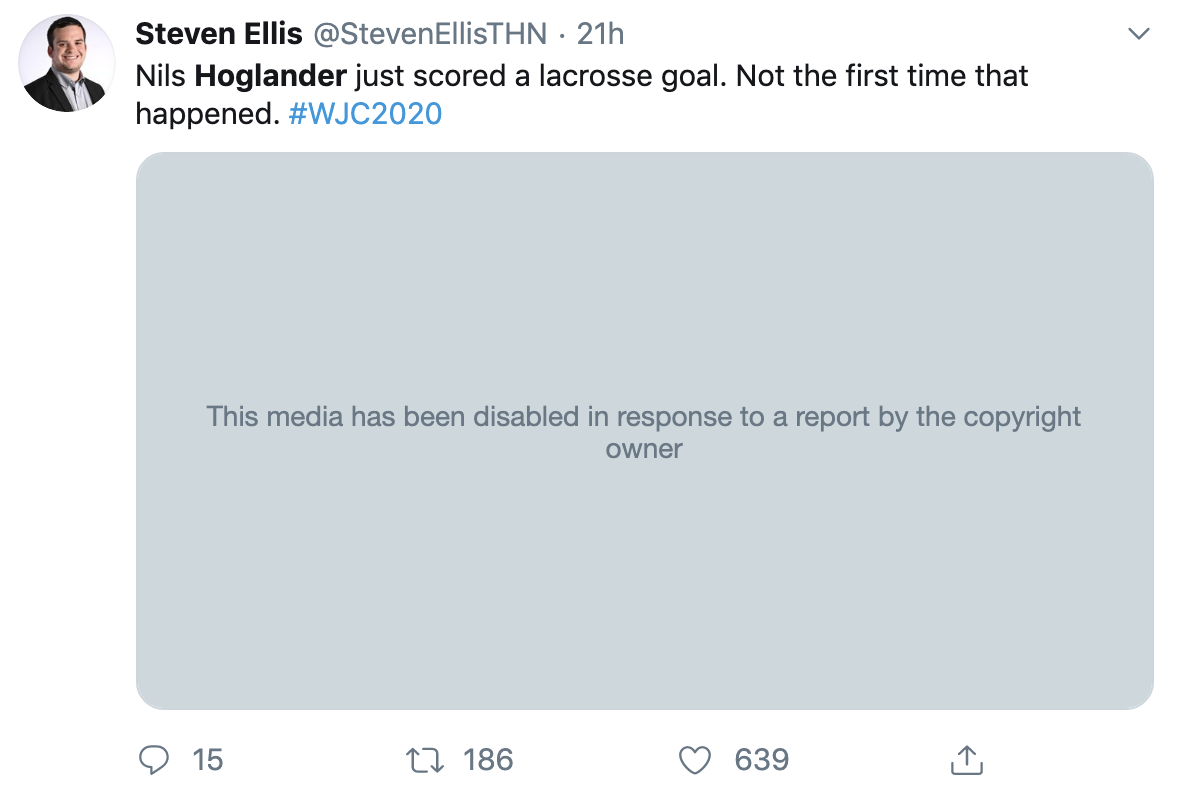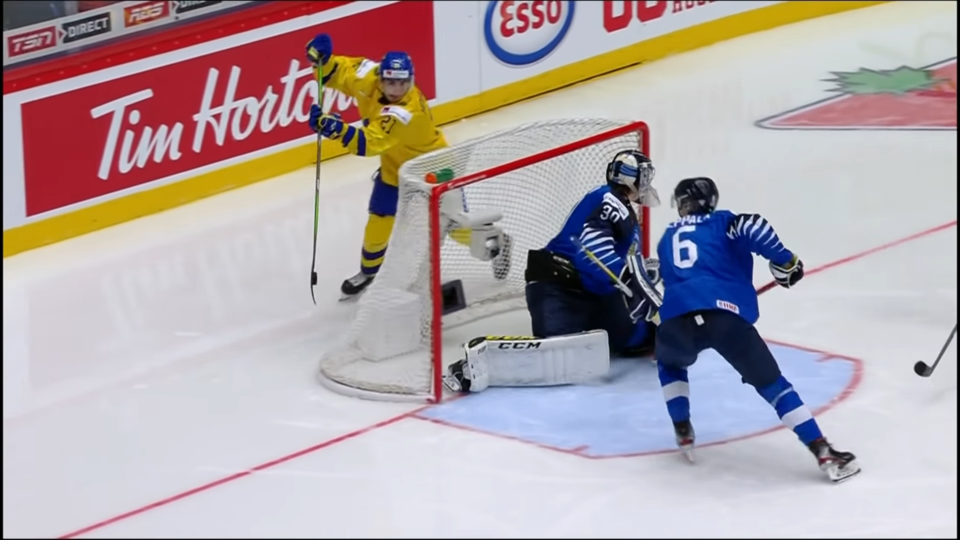Nils Höglander did it again.
Two months after he scored an , Höglander brought the same move to the World Junior Championship, scoring a gorgeous goal for Sweden against their longtime Nordic rivals, Finland.
There are debates over what to name this type of goal. The go-to descriptive term is a “lacrosse” goal, simply because it looks like a player is handling the puck like a lacrosse player handles a ball. Some call it The Michigan, after for the University of Michigan back in 1996. Some name it a Mike Legg goal for the same reason. There’s a movement afoot to name it The Svechnikov, after the Carolina Hurricanes’ this season, .
In Sweden, they call it a “Zorro-mål,” which directly translates to “Zorro goal.” In some quarters, lifting the puck up onto your stick is called “Zorroing” the puck, because the Z-shape movements generally required to keep the puck elevated on the blade of the stick look like with his sword.
Calling it a Zorro Goal also makes sense as it’s a swashbuckling type of move, that requires skill, daring, and panache, all things that typify Zorro.
They don’t get much better than , where he was under pressure from a defender when he pulled off the move. Normally, the move is only attempted when a player has a lot of time and space behind the net, which is what made Höglander’s SHL version of the goal so impressive: he banked the puck off the back of the net to himself around the defender, then evaded a stick-check while, in the same motion, pulling the puck up onto his blade and slinging it over the shoulder of the goaltender.
The version Höglander pulled out against Finland wasn’t quite as technical as what he did in the SHL, but it was still very impressive, as it was done with such incredible speed.
Generally, the move works because the goaltender doesn’t expect it, but Finnish goaltender Justus Annunen had a chance to see Höglander Zorro the puck up onto his stick at one side of the net and react to come across to the other side. It didn’t matter: Höglander was moving at such speed that Annunen had no chance to stop the puck when the Swedish winger whipped it into the top corner while he was still behind the net.
To make that move in international competition in a key game against Sweden’s fiercest rival takes plenty of chutzpah, and it’s part of the reason Â鶹´«Ă˝Ół»fans are so excited about Höglander, who the Canucks selected early in the second round of the 2019 draft. He’s looking a lot more like the first-round pick some projected him to be than a typical second rounder.
It was a goal destined to go viral. It’s understandable that the rights holders for the World juniors, TSN, would want it to go viral for them and not someone else. As dozens of Twitter accounts shared clips of Hoglander’s goal, TSN quickly issued copyright claims, causing several videos to get taken down.

As much as TSN is in their rights to make those copyright claims, some would argue their actions are misguided.
TSN no longer has national broadcasting rights to the NHL in Canada, which means its marquee hockey product is international hockey. Unfortunately for them, a lot of international hockey doesn’t attract a lot of attention in Canada
The world championships are overshadowed by the NHL playoffs, Olympic hockey is less of a draw without NHLers on the rosters and is split with other broadcasters, and the Spengler Cup is a niche tournament. Perhaps they could make a stronger marketing push with women’s hockey, but they have yet to do so.
The World Junior Championships, however, are a bigger draw. Beyond the nationalistic fervour generated by seeing teenagers playing for their country, the World Juniors attracts NHL fans eager to see their team’s prospects perform on the world stage, as well as draft junkies trying to assess the top prospects for the upcoming draft.
Most importantly, it’s good, entertaining hockey. Many of the players in the tournament will go on to star in the NHL, but these are also inexperienced kids, prone to make mistakes. The combination of elite skill and defensive lapses can lead to some spectacular highlights.
The question is whether a rights holder should prevent those highlights from being widely disseminated on social media or carefully guard those highlights in hopes that people will share their own clips and videos.
This has been a long debate in sports circles, with the NFL and MLB sparking the debate in the past.
The NFL back in 2015, with copyright claims leading to the temporary shutdown of @deadspin and @sbnationgif. , cracking down on anyone and everyone that shared video clips or gifs of baseball highlights, and was , temporarily shuttering popular baseball pitching account .
At its heart, the debate centres around what is “fair use,” which is what determines whether copyrighted material can be used without permission or a license. The general principles of “fair use” are that the use of the material is “transformative” in some way, using it for a different purpose than the original material, and that it is a “reasonable” amount of the material.
Therefore, the debate isn’t about whether TSN owns the copyright for these clips — they do — but whether sharing a short highlight clip on Twitter is “fair use.”
A video clip or gif of a hockey highlight would seem to fall under the “fair use” banner. The mere act of clipping the highlight is transformative, as it’s not being broadcast the same way as the game on TSN. It’s also a “reasonable” amount of the original broadcast, as it’s just a short clip of the entire game, just a few seconds out of the hours of gameplay.
It could also be argued that a viral goal like Höglander’s only helps TSN, no matter who is creating and sharing the video. The fact the goal happened on the very first day of the tournament couldn’t be more ideal, as it reminds people that the World Juniors have started and that they have a chance to watch incredible goals like Höglander’s if they tune in.
That’s the approach of the NBA, who actively encourage fans to create and share their own videos and gifs, with the understanding that it can only help the NBA’s brand to have a large, passionate community of fans sharing their love for the game.
TSN’s copyright claims weren’t ubiquitous, with plenty of gifs of Höglander’s goal available on Twitter, Instagram, and elsewhere, but enough were taken down that it perhaps didn’t reach as many people as it could have. Most accounts deleted their tweets with the copyright claimed clip.
Clips of Höglander’s game-tying assist didn’t get hit with a copyright claim, making it pretty clear that TSN was less concerned with protecting their copyright and more concerned with getting more retweets and likes on their own video of Höglander’s goal.
Samuel Fagemo ties the game with 5 minutes left to play. Hoglander with the primary assist.
— /Cam Robinson/ (@Hockey_Robinson)
Höglander finished with a goal and an assist in the first game of the tournament, as Sweden scored a power play goal in overtime to dispatch Finland 3-2. It was a key victory for Sweden that could lead to them winning their group, as Finland is their toughest competition in Group A.
For his efforts, Höglander was named player of the game for Sweden.
Ěý



